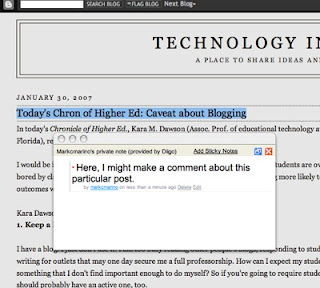In today's
Chronicle of Higher Ed., Kara M. Dawson (Assoc. Prof. of educational technology at the University of Florida), reflects on "
Blog Overload" in her classroom.
I would be interested to hear your reflections on Dawson's key contention that students are overwhelmed and/or bored by classroom requirements to blog, and her tips for how to make blogging more likely to yield the learning outcomes we seek.
Kara Dawson's Tips for better classroom blogging are:
1. Keep a Blog YourselfI have a blog. I just don't use it. I am too busy reading other people's blogs, responding to student postings, and writing for outlets that may one day secure me a full professorship. How can I expect my students to devote time to something that I don't find important enough to do myself? So if you're going to require students to create a blog, you should probably have an active one, too.
2. Recognize Individual Learning Styles and Preferences.I find it funny that I would have to remind myself of that, given that I am expert in pedagogy. Before blogs came along, I offered my students multiple options for demonstrating their knowledge. Some created concept maps, others audio-recorded their thoughts (prior to podcasts), many kept individual journals, and others created movies or presentations. All students were responsible for demonstrating their interaction with class content from week to week and sharing the results. In retrospect, that is not such a bad plan. I can simply offer blogs as another possible option.
3. Encourage Bloggers to Produce More than Just TextWhen I included a requirement that all students integrate at least three forms of multimedia in their blogs by the end of the semester, I envisioned creations like podcasts and Gliffy concept maps. What I got was links to YouTube videos and pre-existing podcasts and images. Clearly, the use of blogs has unintentionally decreased the way my students interact with course content. I need to recognize that. I need to be more explicit in my expectations for the use of blogs.
4. Recognize the Nature of the BeastThe most effective blogs provide important and cutting-edge information (e.g., Tech Crunch), communicate deeply personal experiences through narrative (e.g., the Cancer Blog), or write to a specific audience (e.g., chemistry teachers). Most people with successful blogs are deeply committed to posting, for personal reasons, such as a passion for their subject, the satisfaction of reaching a wide audience, or the ego boost associated with having others find their narratives important enough to read. Many people with successful blogs also have an innate slant toward the writing profession.
I need to recognize all of those facts, and redefine my expectations and purposes for using blogs in the classroom.
5. Don't Forget "Old" TechnologiesSince the advent of blogs, I had moved away from online discussion forums. I viewed them as clunky, passé even. Now I realize they still have merit. It is very difficult to have an extended conversation within blogs. By their very nature, they position one person at the helm of all activity. The threaded format of discussion forums allow for multiple interactions among multiple individuals. It also allows subtopics to flow from a broad topic.
6. Don't Be Afraid to Punt.I should have ceased -- or at least modified -- the way I used blogs last semester. I asked my students for their opinion on the topic but few responded. I am very open to student suggestions but know that is not true of all faculty members. My students may have feared retribution. They may have just not cared enough to comment. So from now on, blogs will be a socially negotiated addition to my coursework.
Kara's ConclusionWhile some readers may take my comments as an attack on the merit of using blogs in teaching and learning, I still believe they have a definite role to play -- especially given what we know about the importance of metacognition and social interaction in the learning process. My hope in sharing these insights is merely to help others consider what that role might be in their own classrooms.
 One challenge to the paperless classroom, particularly in the case of blogs, is delivering comments on the electronic writing to the student. What if you could write notes directly on the digital text as you do paper? The social bookmarking and annotation sharing software, Diigo, offers one free, easy-to-use alternative.
One challenge to the paperless classroom, particularly in the case of blogs, is delivering comments on the electronic writing to the student. What if you could write notes directly on the digital text as you do paper? The social bookmarking and annotation sharing software, Diigo, offers one free, easy-to-use alternative.

